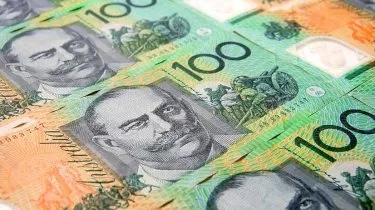Invest
Cash remains king for many Australians
Demand for banknotes remains high despite a decline in cash transactions.
Cash remains king for many Australians
The value of banknotes in circulation has surged 20 per cent since the start of the COVID-19 pandemic as Australians hoard billions of dollars in cash.
In a paper released as part of a review into banknote distribution, the RBA said that the “extraordinarily high” demand for cash since the start of 2020 was significantly higher than the 6 per cent annual growth recorded prior to the pandemic.
While demand for cash has hit decade highs, payments using cash have continued to fall.
The RBA found that the proportion of retail payments made using cash fell from 69 per cent in 2007 to 27 per cent in 2019, with the pandemic further accelerating this decline.

“The increase in banknotes in circulation against the backdrop of declining transactional cash use can be attributed to the growing role of cash for precautionary and/or store-of-wealth purposes,” the RBA explained.
Estimates suggest that half to three-quarters of the $100 billion of banknotes currently in circulation are being hoarded.
As a result, $50 and $100 notes now account for 73 per cent of the number and 94 per cent of the value of all banknotes in circulation compared to a “subdued” demand for $5, $10 and $20 notes, according to the RBA.
“The store-of-wealth function performed by banknotes is particularly important during times of financial and economic uncertainty, such as the global financial crisis (GFC) and the COVID-19 pandemic,” the RBA said.
“Consequently, cash demand often surges during times of economic stress, driven by an increase in high-denomination banknotes.”
Additionally, low-interest rates further increased the appeal of holding cash.
The value of currency in circulation as a percentage of GDP spiked to a record high of 4.8 per cent during the March quarter of this year before easing back slightly.
Despite the increased levels of hoarding and decreased levels of transactions, the RBA highlighted that cash remains critical to certain parts of the population, including individuals who are older, have a lower household income, live in regional areas or have limited access to the internet.
The RBA’s 2019 Consumer Payments Survey found that 15 per cent of Australians used cash for 80 per cent of their in-person transactions.

Cash
Cash usage in Australia continues to decline as digital payments rise
In the ever-evolving landscape of financial transactions, Australia is witnessing a significant shift away from cash, as revealed by Worldpay's latest Global Payments Report. According to the report, ...Read more

Cash
Navigating the equilibrium: Investor sentiment in the face of equity peaks and diminishing cash reserves
State Street's latest Risk Appetite Index indicates a nuanced shift in institutional investor sentiment during March, with the index reverting slightly towards neutrality. This subtle recalibration in ...Read more

Cash
RBA's November rate hike overshadows Melbourne Cup festivities
In a move that managed to draw attention away from the thrill of the Melbourne Cup, the Reserve Bank of Australia (RBA) has increased the cash rate by 25 basis points to 4.35 per cent, surprising ...Read more

Cash
RBA makes first cash rate call for 2022
The RBA has announced its first rate decision for 2022. Read more

Cash
Interest rates to rise next year?
Commonwealth Bank has seconded Westpac’s predictions, forecasting that interest rates will rise well ahead of the RBA’s 2024 timeline. Read more

Cash
RBA makes latest official cash rate call
The Reserve Bank of Australia has made its May call on the official cash rate, with the economy said to be a long way from the conditions needed to precede a rate rise. Read more

Cash
RBA puts chatter of an earlier rate hike to rest
The Reserve Bank of Australia has put to rest chatter among investors that conditions for a higher cash rate could be met as early as next year, reaffirming its stance that the rate is “very likely” ...Read more

Cash
Australia tipped to go cashless by 2024
Australia is forecast to effectively go cashless in just three years, with three in 10 Aussies admitting that “going cashless would be great for the country”. Read more

Cash
Cash usage in Australia continues to decline as digital payments rise
In the ever-evolving landscape of financial transactions, Australia is witnessing a significant shift away from cash, as revealed by Worldpay's latest Global Payments Report. According to the report, ...Read more

Cash
Navigating the equilibrium: Investor sentiment in the face of equity peaks and diminishing cash reserves
State Street's latest Risk Appetite Index indicates a nuanced shift in institutional investor sentiment during March, with the index reverting slightly towards neutrality. This subtle recalibration in ...Read more

Cash
RBA's November rate hike overshadows Melbourne Cup festivities
In a move that managed to draw attention away from the thrill of the Melbourne Cup, the Reserve Bank of Australia (RBA) has increased the cash rate by 25 basis points to 4.35 per cent, surprising ...Read more

Cash
RBA makes first cash rate call for 2022
The RBA has announced its first rate decision for 2022. Read more

Cash
Interest rates to rise next year?
Commonwealth Bank has seconded Westpac’s predictions, forecasting that interest rates will rise well ahead of the RBA’s 2024 timeline. Read more

Cash
RBA makes latest official cash rate call
The Reserve Bank of Australia has made its May call on the official cash rate, with the economy said to be a long way from the conditions needed to precede a rate rise. Read more

Cash
RBA puts chatter of an earlier rate hike to rest
The Reserve Bank of Australia has put to rest chatter among investors that conditions for a higher cash rate could be met as early as next year, reaffirming its stance that the rate is “very likely” ...Read more

Cash
Australia tipped to go cashless by 2024
Australia is forecast to effectively go cashless in just three years, with three in 10 Aussies admitting that “going cashless would be great for the country”. Read more









